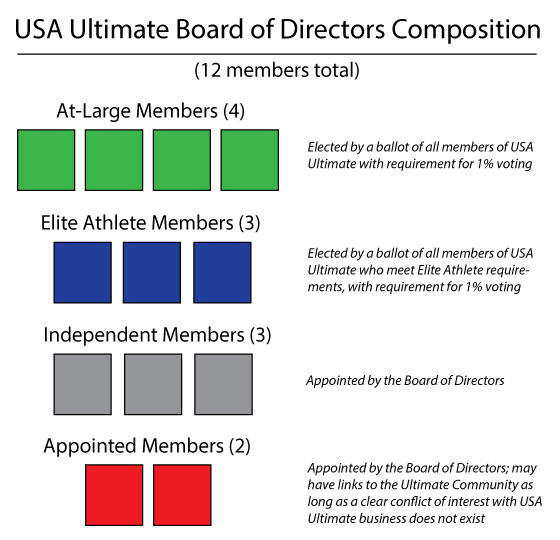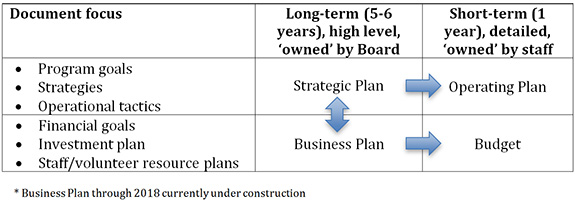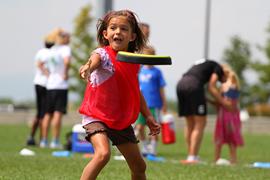1) Moving towards Olympic status, and continued dominance of the U.S. National Teams
When we embarked on the 1½-year endeavor to rewrite and approve a new set of bylaws, Ultimate’s Olympic future was at the forefront of our minds. Why? Because the national governing bodies (NGBs) of member sports in the U.S. Olympic movement have very strict bylaws requirements imposed by the U.S. Olympic Committee (USOC), intended to ensure stability of those NGBs as well as alignment with USOC operating procedures.
The decision to align our bylaws with USOC requirements was not a simple one, because the requirements are many, and the path towards inclusion in the Olympic program is long. Inclusion of Ultimate as an Olympic sport is at least 20 years off by the estimates of our internal experts familiar with the IOC and USOC. Aside from a strict requirement that a sport must have national governing bodies with male participants in at least 75 countries on four continents, and female participants in at least 40 countries on three continents (Ultimate is currently at 56 countries), there are many other subjective considerations like a sport’s marketability. And, there has to be room in the Olympic games for us, as there is a limit of 28 sports and 10,500 athletes. Thus, a current sport must be omitted for us to be included.
Despite these hurdles and the time it may take to overcome them, the USA Ultimate Board of Directors believes that the Olympics would be an excellent showcase for our sport in the future. And although there are some in the community that believe progression towards Olympic status will erode key values of our sport, we believe those values can be preserved and showcased. Of particular consequence in our decision was the excitement our younger members – the fastest-growing part of USA Ultimate – have about the U.S. National Team and progress towards the Olympics.
To support gradual movement towards Olympic status, we decided to take steps to align our bylaws with those currently recognized by the USOC. Representatives of our staff and board met with USOC officials to ensure we are on the right track.

As Ultimate grows on the international sporting stage, it is important that the governance
of USA Ultimate is aligned with other national governing bodies of sport.
PHOTO: CBMT Creative
There were several administrative and procedural requirements that were built into the new bylaws, including allocation of three appointed board seats to independent directors to reduce the potential for conflicts of interest, identification of external arbitration as opposed to board appeal as the final step in USA Ultimate’s judicial process, mention of the Ted Stevens Olympic and Amateur Sports Act, specific mention of USA Ultimate’s relationship to WFDF as the international federation, and elimination of the Executive Committee to ensure that board decisions are made by the full board.
However, perhaps the most exciting requirement from the USOC that has been built into the new bylaws is the stipulation for representation of Elite Athletes on the USA Ultimate Board and Committees. The USOC requires its member NGBs to allocate at least 20% of seats on the Board to ‘elite athlete representatives,’ elected by other elite athletes. Elite athletes are defined as those that have a) competed in a World Championship on behalf of the United States in the past 10 years, or b) finished in the top half of National Championships in the past two years. During fall 2013, USAU will implement a separate election process among Elite Athletes to begin electing representatives. We will develop a process to identify elite athlete representatives for appointment to our key committees (Governance & Board Development, Nominating, Audit & Ethics, Judiciary, SOaR), as the 20% requirement also holds for these important groups.
These changes to the bylaws are, of course, just the tip of the iceberg when it comes to USA Ultimate’s increased commitment to ensuring excellence of U.S. National Teams in international competition, including a potential path towards Olympic status. In our new Strategic Plan, success of the U.S. National Team is amongst our top six goals for the next six years. We plan to revisit and refine team selection processes, provide gradually increased financial and operational support (as sustainable resources allow), develop a true program for national team coaching, and develop and communicate guidelines for athlete development to support future members of the national team.
2) Selecting the right Board of Directors for USA Ultimate’s future
I believe that being a member of the USA Ultimate Board is very serious business. A few key reasons for this, among many:
|
|
•
|
We have the largest pool of money in our sport (~$3.0M annual budget), and it is our duty to direct the use of that money in ways that support our mission, as well as the interests of our members and the Ultimate community as a whole, both now and looking to the future.
|
|
|
•
|
The fact that USA Ultimate is the official governing body for Ultimate in the U.S. is also very serious business – WFDF mandates that USA Ultimate oversees the U.S. National Team, and it is our duty to ensure the best teams are chosen and fielded to represent the United States, in a fair way.
|
|
|
•
|
We have a full-time staff of 14 in Colorado who depend on us for their livelihood, so any decision that affects them must be taken very carefully.
|
|
|
•
|
Finally and most importantly, we have a basic responsibility to our tens of thousands of members, as well as the millions that love and play Ultimate in the U.S., to make smart decisions on behalf of the sport.
|
Serious business requires serious leadership, and at USA Ultimate the buck stops with the board. As the organization and sport grows, we need board members with the right perspectives and expertise to make smart decisions. The requisite expertise for the foreseeable future is likely different from what it was 10 or 20 years ago when the sport was smaller, and we didn't have a full-time staff. As a result, when we rewrote the bylaws we made significant changes in how the board is selected. There were a few goals of these changes:
|
|
•
|
Align ourselves with standard practices in the national governing body world as they relate to elite athlete representation (per article #1).
|
|
|
•
|
Reduce potential for intra-sport conflicts of interest by allocating three seats to independent board members (Independent board members are those that have had no association with Ultimate for the past two years).
|
|
|
•
|
Ensure our ability to install skills/resources on the board, which are necessary and beneficial for our leadership of the organization. For example, having directors with legal expertise on our board has proven very helpful, and we need the ability to appoint a lawyer (or others with high-level skill sets in areas like marketing, fundraising, finance, business or strategic planning) to the board in case none are elected through the general election and/or elite athlete election processes.
|
|
|
•
|
Eliminate geographic region representatives from the general election. It is our belief that national representatives can effectively protect/serve the interests of players from all regions. As a result, the regional spots will be phased out and only at-large spots will remain in the general election.
|
Given these goals, the new bylaws dictate that over the next three years we will move towards the following structure for the USA Ultimate Board of Directors:
|
|
•
|
Four (4) At-Large Board members (elected by a ballot of all members of USA Ultimate with requirement for 1% voting… in the past several years we have had 1-3% participation of the membership in at-large elections)
|
|
|
•
|
Three (3) Elite Athlete Board members (elected by a ballot of all members of USA Ultimate who meet Elite Athlete requirements, with requirement for 1% voting)
|
|
|
•
|
Three (3) Independent Board members (appointed by the Board of Directors)
|
|
|
•
|
Two (2) Appointed Board members (appointed by the Board of Directors; may have links to the Ultimate Community as long as a clear conflict of interest with USA Ultimate business does not exist)
|

There is one important final thing to mention about representation on the board. Just as we re-thought geographic representation, so also the thinking has shifted on the representation of other key constituencies like playing divisions, coaches, observers, corporate partners, parents, etc. At this point in the evolution of Ultimate there are lots of constituencies, and while we’d like each one to have direct representation on the board, our experience, as well as that of non-profit experts, suggests that having a board of more than ~12 people does not work well.
As a result, we are planning to move towards a model in which key constituencies (e.g., affiliated league leaders, coaches, elite players, and potentially many others) are represented by Working Groups whose leads interact with the directors at board meetings, both to provide input to the board and also to partner with the board as we make decisions that affect those constituencies. The first example of this new model is being rolled out in the second half of 2013 in the form of a new divisional representation structure for competitive teams. Working Groups are being formed for each broad division (Youth, College, Club, Master’s, Beach, International) and within the Club area we are piloting an ‘Athlete’s Council’ approach with men’s, women’s, and mixed Councils. The board and USA Ultimate staff will be diligent in engaging these Working Groups and Councils periodically, and as key decisions are made. Stay tuned for more on this new model.
3) Managing USA Ultimate to ensure growth and stability in our sport
Fifteen years ago, USA Ultimate had only one full-time staff member. As a result, we counted on the board of directors to do anything and everything, including detailed tasks like computer programming, accounting, events leadership, and creation of the newsletter. As a result, our old bylaws were actually quite unspecific regarding the role of the board.
In today’s world, we are in the fortunate position of having a dedicated and professional full-time staff and a moderate amount of financial resources (though we can always use more to help the sport grow faster!). As a result, the board can and should be allowed to focus its time in the three key areas any mature board must:
|
|
1.
|
Proactively defining the organization’s goals and identifying strategies to achieve those goals over time
|
|
|
2.
|
Assist in revenue generation for the enterprise, especially in the area of fundraising
|
|
|
3.
|
Mitigating risks to the organization, its members, and the sport through both proactive policies and reactive guidance
|
The goal of this article is to describe how the new bylaws help focus the board’s efforts (in the bylaws, mandates for these efforts are in Article 5.2 and Article 7), and highlight some key recent & future board and staff work in these areas.
|
|
•
|
Approve USA Ultimate’s Strategic Plan, Operating Plans, Business Plan, and Budgets: The previous bylaws were not very specific in describing how USA Ultimate would plan effectively for the future of our sport. In any mature organization, key planning documents and processes are a standard part of successful leadership. For USA Ultimate going forward, the documents we will use are shown below.
|

|
While USA Ultimate has (as required by law) always operated using an annual budget, the other documents shown above are relatively new for our organization. The USA Ultimate Strategic Plan has already had incredible impact. The 2008-2012 Plan led to the establishment of the Triple Crown Tour, our growing public media presence with partners like ESPN, and the impressive growth in our youth programs.
The board and staff leadership have been hard at work on these plans for 2013-2018, and are proud that the organization is implementing this level of governance discipline, which is what our members, partners, and other Ultimate community stakeholders deserve.
|
|

Youth initiatives are a significant part of
USA Ultimate’s strategic plan.
PHOTO: UltiPhotos
|
|
|
•
|
Maintain sound financial oversight of USA Ultimate operational funds and invested reserves: Several bullet points in Section 5.2 of the new bylaws outline these responsibilities, which include budgeting, audit & reporting, debt & investment strategies, and appropriate control processes. I am happy to report that we have not waited for these new bylaws to recently ‘up our game’ in these areas. For example, we have:
|
|
|
|
o
|
Enacted the organization’s first Operating Reserve Policy which mandates setting aside reserves equal to 30% of the current year’s operating budget, in case unforeseen circumstances (e.g., a massive storm causes the cancellation of the TCT) put a significant amount of revenue at risk.
|
|
|
|
o
|
Established an official Investment Working Group composed of three accomplished professionals (two of whom are professional money managers), whose job is to give quarterly advice to the board about how to invest the roughly $2 million we currently have in reserves (approximately $900K for the Operating Reserve, and $1.1M that is earmarked for projects supporting the 2013-2018 Strategic Plan).
|
|
|
|
o
|
Started work on the organization’s first five-year Business Plan, which as described in the paragraph above will describe the financial and staff requirements to complete our Strategic Plan, and will act as a long-term financial guidepost for annual budgeting.
|
|
|
|
o
|
Planned to release the organization’s first published Annual Report (later this year), and approve the organization’s first mature philanthropic fundraising plan and program (by early next year).
|
|
|
•
|
Mitigate legal risk for USA Ultimate and protect the legal rights of members: The new bylaws mandate that the board oversees "USA Ultimate’s legal and regulatory compliance program." This is a simple statement that belies a very complex series of programs that protect both the organization and our members’ rights and interests. A few areas to highlight:
|
|
|
|
o
|
Athlete protection: In the wake of recent high-visibility cases of athlete sexual harassment/abuse in college and youth sports, many national governing bodies have revisited their policies to ensure everything possible is being done to protect their athletes. USA Ultimate was no exception. We conducted a thorough review in 2012 using an outside consultant that is well respected in the Olympic sports movement, and were happy to find that our policies and practices (e.g., coach background checks, judicial processes, etc.) were already at the highest standards among sports organizations. We continue to seek ways to protect the organization and its members at every turn.
|
|
|
|
o
|
Insurance: USA Ultimate works closely with a large insurer to cover our members (as well as the board, staff, and volunteers). Our event policy is by far the largest such policy that exists in the world of Ultimate, and by virtue of our relationship with the insurer, the fact that we have an excellent record, and the size of the policy we are able to provide our members with event-based insurance (at events we run, at USA Ultimate sanctioned events, and at select other events through an application process) at no additional charge. We believe this is an incredibly valuable service we provide to members, and we are continually taking steps to both ensure proper coverage and to enact policies that preserve the policy at a good price. One key example was our 2009 decision to eliminate alcohol at college events.
|
|
|
|
o
|
Judicial policies and processes: Article X of the new bylaws, when combined with the referenced Conduct Policy, lays out USA Ultimate’s processes for appeals and grievances in connection with business conducted by our organization. Fortunately, most members never have a reason to read these policies, but I wanted to note that based on our review of other NGBs, we believe that we have a world-class system in place, that is fair and balanced. The new bylaws include two key changes to previous policies:
|
|
|
|
|
|
•
|
Within USA Ultimate, the Judicial Committee, chaired by a board member, will act as the final decision-maker on grievances and appeals. Previously, such decisions could be appealed to the board. The new approach has been taken to ensure more expeditious decisions, and to ensure that the board is not buried by a potentially high volume of such issues.
|
|
•
|
A new option for external arbitration (using an arbiter appointed by the American Arbitration Association) following a decision of the Judicial Committee has been added. It is worth noting that there are certain types of decisions that are not eligible for arbitration (Section 10.9.b), and that the arbiter has the option of compelling the losing party in the arbitration to pay the winning party’s costs of arbitration. This clause in the new bylaws is the industry standard for sport governing bodies, and we are pleased that it makes our overall process more objective.
|
|
4) Focusing on Spirit of the Game (SOTG) as an essential and tangible part of Ultimate
In 2008 we re-wrote the mission of USA Ultimate – "to advance the sport of ultimate in the United States by enhancing and promoting Character, Community and Competition." Putting Character first among the 3 C’s was no accident. Through polls with more than 7,000 member respondents, you told us that the Character of Ultimate including Spirit of the Game (SOTG) is essential to the future of the sport. Key partners in the world of sport (the International Olympic Committee) and media (ESPN) agree – they feel that SOTG is the most important aspect supporting future growth of Ultimate!
In the new bylaws, and our work, we are ‘doubling down’ on SOTG. The previous bylaws did not ignore SOTG – indeed, they specified that USA Ultimate "maintain SOTG as the central governing principle of the sport." In the new bylaws we are more specific and proactive in how that is done (primarily in sections III(8), IV(9). Furthermore, in our new Strategic Plan our fourth goal is to "Make Spirit of the Game real for today’s Ultimate players and community."

Spirit of the Game plays an important role in Ultimate.
PHOTO: CBMT Creative
There are three primary areas of focus here:
|
|
•
|
Clarify and Educate about SOTG: Our survey results show that a majority of members are aware of and support SOTG as a concept. However, your feedback also suggests that we can better describe how SOTG translates into suggestions for how people should behave on the field (e.g., linking SOTG with observer program guidelines on TMFs), and in the Ultimate community at large. Also, we want to be more explicit in showing how SOTG informs the decisions that USA Ultimate administrators make, from policies (e.g., gender equity policy) to rule-making (e.g., specific role of observers) to grievance decisions (e.g., decisions on conduct violations) and more. Per our Strategic Plan, in the next year we will kick off a major effort in the community to clarify and communicate how SOTG applies to Ultimate, on and off the field. We will be soliciting the input of the entire community, and will work with you through online channels to finalize the ‘education program’ for SOTG that will be used going forward with future generations of Ultimate participants.
|
|
|
•
|
Lead USA Ultimate with SOTG in mind: The Rules of Ultimate have always started with a statement about the importance of SOTG. Additionally, USA Ultimate administrators have overseen our observer program with the tenets of SOTG in mind. However, in 2012 we realized that we lacked a consistent, detailed mechanism by which we can ensure that SOTG is appropriately considered as rules evolve (and are experimented with), as observers are trained and deployed, as coaches are trained, and as other activities are undertaken by USA Ultimate. To fill this void, and to signify the importance of SOTG within USA Ultimate, we have established a board-level committee called the Spirit, Observers, and Rules (SOaR) Committee. The charter of the SOaR Committee is to "oversee, review and recommend policy-level decisions in the areas of rules and observers (and other areas as necessary) to ensure consistency in strategy, policy, and tactics across these areas." The SOaR Committee has already overseen review and approval of experimental rules for several tournaments, and for the College and Club seasons during the past two years. In the near future, the role of the committee is likely to include making recommendations on potential rules revisions to make the sport more TV-friendly, and review of USA Ultimate’s Observer and Coaching Policies and processes.
|
|
|
•
|
Publicize those that exemplify SOTG: In the early years of Ultimate, community interaction occurred largely at tournaments. In those days, ‘making an example’ of spirited players was focused on tournament-based Spirit Awards, for both teams and players. The community was small enough so it was relatively easy for new players to watch and get to know Spirit winners, and emulate them. Now the Ultimate community is much larger, and media is a much bigger part of it. Therefore we have an opportunity to fundamentally improve how SOTG is modeled within (and outside) the community. As a result, we are committing to a new media focus on highlighting spirited teams and players – through our own media channels (website, Twitter, Facebook) and through those of our partners (online and television). Beyond the traditional awards, you can anticipate much more ‘story-telling’ – written and video exposés to describe the conditions under which a player or team showed great Spirit, as well as the outcomes. We believe that a story-based approach will be very effective in attracting new players (especially kids) to our sport while maintaining the incredible character that have made all of us so passionate about Ultimate.
|
|